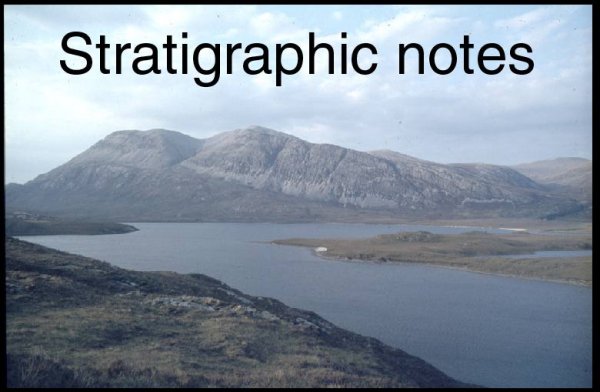

View stratigraphic column and photographs
One of the key advantages of studying thrust structures in the Moine thrust Belt is the stratigraphy. The rock units that were stacked up in thrust sheets are remarkably varied and distinctive. Most critically, the Cambro-Ordovician strata that make up most of the sedimentary cover show very little lateral variation in thickness or broad facies along regional strike (NNE-SSW). This consistency is assumed to have existed in the across strike (ESE) direction so that these units formed a layer-cake stratigraphy. The rock sequence is summarised in a number of reviews (e.g. Johnstone & Mykura 1989)
The basement in NW Scotland is the Lewisian complex. These early Proterozoic gneisses show variable structures and tectono-metamorphic episodes. Some of these features may be used to correlate between the foreland and the orogen. The gneisses are overlain by the neo-Proterozoic Torridonian supergroup sediments. These continental clastics bury a palaeo-landscape than shows considerable relief, the most spectacular portions of which are visible on the north side of Loch Maree, underpinning the mountain of Slioch.
In contrast to the Torridonian rocks, the Cambro-Ordovician strata in NW Scotland are exclusively marine. They overlie a strikingly simple unconformity, a marine planation surface, that oversteps from Torridonian onto Lewisian rocks. The overlying strata (Eriboll Sandstone Group), of lower Cambrian age, are cross-bedded shallow-marine quartzites, the upper half of which is bioturbated. The ubiquitous presence of skolithos trace fossils give this unit its name, the Pipe Rock. In detail the characteristics of sediments and burrows are variable upsection so that local marker units (e.g. storm horizons) may be used to correlate across imbricate thrusts. Overlying these quartzites is a more varied sequence of sands and shales which were also deposted in shallow water (possibly lagoonal, the Fucoid Beds) and a further thin quartzite (the Salterella Grit). Collectively these units constitute the An t-Sron Group. Above lie the carbonates of the Durness Group. These range in age from late Cambrian to Arenig (Ordovician) in age. The carbonates are remarkably clean with virtually no shale interbeds. The nature of the top of the Durness succession is unknown from NW Scotland as it is always truncated tectoically, most commonly by the Moine thrust.
The nature of the Cambro-Ordovician strata influence the development of thrusts. Most obviously, the base of the Fucoid Beds and the base of the Durness carbonates form regionally extensive easy-slip horizons. Consequently the An t-Sron Group commonly develops duplexes bounded by floor and roof thrusts gliding at these stratigraphic levels. However, less obviously, bedding planes within the Pipe Rock also form regional easy-slip horizons, particularly some near the base of this unit. Some levels within the Durness carbonates also form flats. The best development of these types of mechanical stratigraphic behaviour are found in the northern part of the thrust belt. In the south imbrication tends to involve the entire succession.
View stratigraphic column and photographs
| Moine Thrust Belt front page |